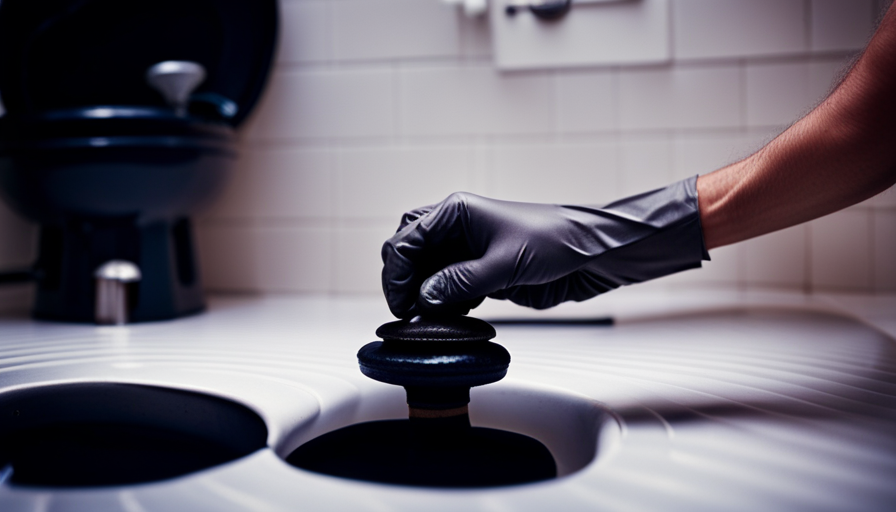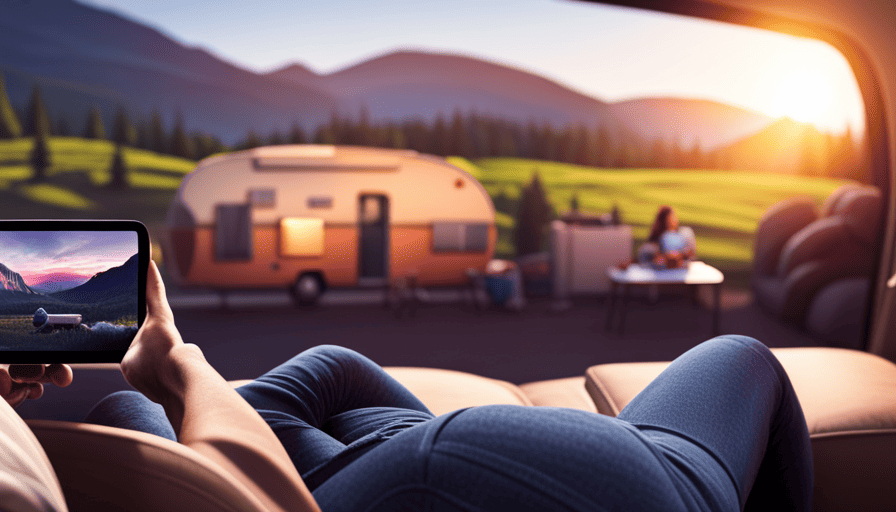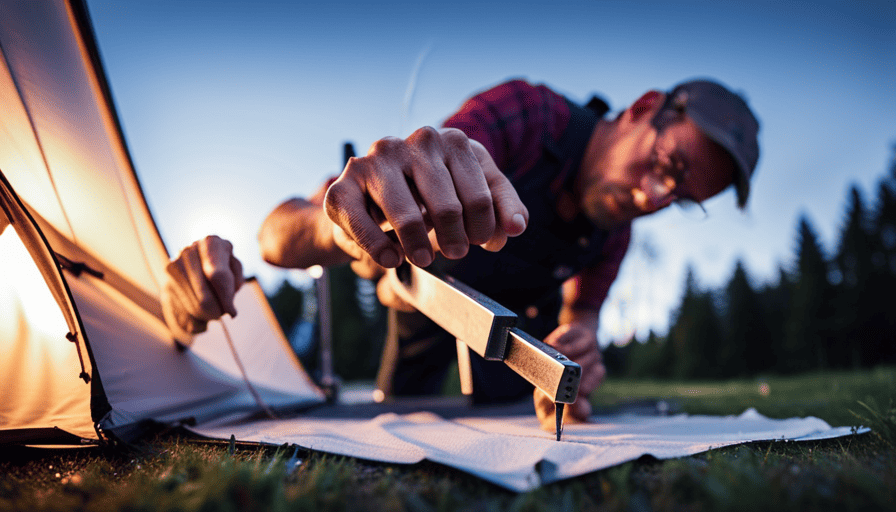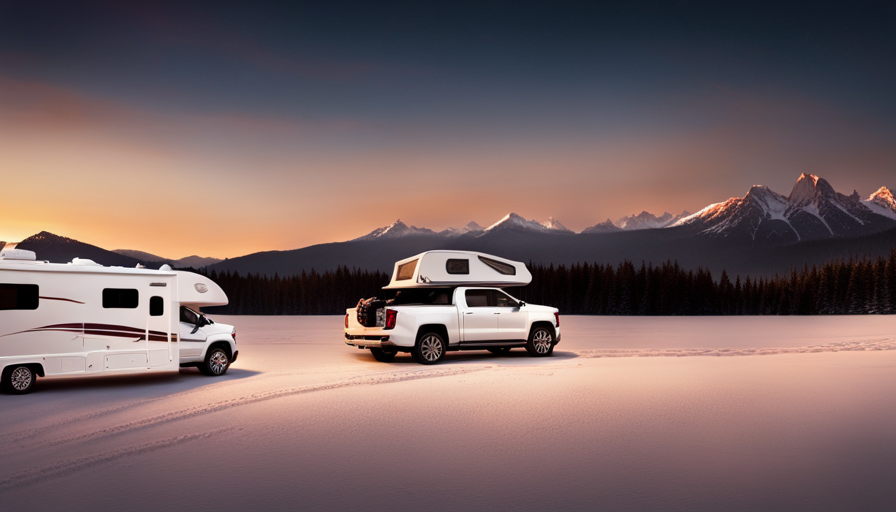Hello, fellow adventurers! Tired of dealing with a clogged camper toilet while on the road? Fear not! We’ve got you covered. This comprehensive guide will take you step by step through the process of unclogging your camper toilet, so you can keep enjoying your travels without any unwanted delays.
Now, I know what you’re thinking – unclogging a toilet may seem like a daunting task, but trust me, it’s not as complicated as it sounds. With a few simple supplies and a little know-how, you’ll be able to tackle even the toughest clogs in no time.
From using a plunger and a toilet auger to chemical drain cleaners and plumbing snakes, we’ll cover all the tried-and-true methods for unclogging your camper toilet.
And don’t worry, we’ll also share some tips on how to maintain proper toilet maintenance to prevent future clogs.
So, whether you’re a seasoned camper or a newbie adventurer, keep reading to learn everything you need to know about unclogging your camper toilet.
Get ready to say goodbye to those pesky clogs and hello to worry-free travels!
Key Takeaways
- Regular maintenance and proper toilet usage can prevent camper toilet clogs.
- Using a plunger or a plumbing snake is effective for unclogging minor to stubborn clogs.
- Hot water and dish soap can be used as a first step for unclogging camper toilets.
- Hiring a professional plumber may be necessary for tough clogs and to ensure the job is done correctly.
Gather the necessary supplies
Now it’s time to gather all the supplies you’ll need to unclog that stubborn camper toilet. Camper toilet maintenance is crucial to ensure a hassle-free camping experience.
To start, you’ll need a plunger specifically designed for RV toilets. Unlike regular plungers, this type has a smaller, cone-shaped rubber head that fits perfectly into the camper toilet bowl. Additionally, you’ll want to have a pair of rubber gloves to protect your hands from any unpleasant mess.
Another essential item is a bottle of RV-safe toilet chemical. This will help break down waste and prevent future clogs. It’s also a good idea to keep a toilet brush and some cleaning solution handy for regular maintenance.
Common causes of toilet clogs in campers include using too much toilet paper or flushing non-biodegradable items down the toilet. By being mindful of what goes into the toilet, you can minimize the chances of clogs occurring.
Now that you have all the necessary supplies, it’s time to assess the severity of the clog and determine the best course of action.
Assess the severity of the clog
First, check the state of the water to determine the extent of the blockage. This step is crucial in assessing the severity of the clog and troubleshooting possible causes. Look for signs such as slow drainage, water backup, or complete inability to flush. If the toilet bowl is filled with an excessive amount of water, the clog is likely severe and may require more aggressive measures to resolve.
On the other hand, if the water level is relatively low, the clog may be less severe and easier to address. To troubleshoot the causes of the clog, consider any recent actions or items that may have contributed to it. Did you flush excessive toilet paper or dispose of anything other than human waste and toilet paper? Is there a possibility of a foreign object, such as a toy or hygiene product, obstructing the toilet? Understanding the potential causes will help determine the best approach to unclogging the camper toilet.
With the severity of the clog assessed and the potential causes considered, we can now move on to the next step: using a plunger to try and dislodge the clog.
Use a plunger to try and dislodge the clog
To tackle the stubborn blockage, grab a plunger and give it your all, plunging with force and determination. Here are some tips to effectively use a plunger and potentially dislodge the clog:
- Position the plunger over the drain hole, ensuring a tight seal.
- Push down firmly on the plunger handle to create suction.
- Pull up sharply to create pressure and dislodge the clog.
- Repeat this plunging motion several times, varying the force and speed.
- If the water starts to drain, continue plunging until the toilet flushes properly.
If the plunger doesn’t work, there are alternative methods you can try. One option is using a toilet auger, which is a flexible tool that can reach deeper into the drain. Insert the auger into the toilet bowl and rotate the handle clockwise to break up the clog. Another alternative is using a mixture of hot water and dish soap to break down the blockage. Pour a cup of dish soap and a bucket of hot water into the toilet bowl, let it sit for a few minutes, and then attempt to flush the toilet.
To prevent future toilet clogs, remember to only flush toilet paper and human waste. Avoid flushing items like sanitary products, wipes, or excessive amounts of toilet paper. Regularly cleaning your toilet and maintaining a healthy septic system can also help prevent clogs. With these tips, you’ll be well-equipped to tackle any clog that comes your way.
Moving on to the next section, if the plunger and alternatives don’t work, we can explore how to use a toilet auger to unclog your camper toilet.
Use a toilet auger if the plunger doesn’t work
If the plunger isn’t doing the trick, don’t worry, there’s another tool you can turn to – a trusty toilet auger. A toilet auger, also known as a closet auger, is a long, flexible rod with a coiled wire at one end and a handle at the other. It is specifically designed to tackle stubborn clogs in toilets.
To use a toilet auger, start by inserting the coiled end into the toilet bowl, making sure it goes past the trap and into the drain pipe. Then, slowly crank the handle in a clockwise motion while applying gentle pressure. The coiled wire will extend into the drain pipe, grabbing onto the clog and allowing you to break it up or pull it out.
Toilet augers are effective at clearing clogs caused by toilet paper, waste, or foreign objects that have become stuck in the drain pipe. However, it’s important to note that using a toilet auger can be challenging in tight spaces, such as a camper bathroom. In such cases, you may need to consider alternative methods, such as using a plunger with more force or seeking professional assistance.
If the toilet auger doesn’t solve the problem, it’s time to explore other options. In the next section, we’ll discuss using a chemical drain cleaner as a last resort, but before we get to that, let’s dive into the common causes of camper toilet clogs.
Use a chemical drain cleaner as a last resort
When all else fails, you can resort to using a powerful chemical drain cleaner to obliterate the stubborn clog in your camper’s toilet. However, it’s important to exercise caution when using these chemicals, as they can be harmful if not handled properly.
Before using a chemical drain cleaner, make sure to read and follow the instructions provided by the manufacturer. Wear protective gloves and goggles to shield your skin and eyes from any potential splashes or fumes.
Keep in mind that chemical drain cleaners should only be used as a last resort, as they can damage your plumbing system over time. If you’re concerned about the safety of using chemical drain cleaners, there are alternative methods you can try.
For example, you can attempt to break up the clog by pouring hot water and dish soap down the toilet. This combination can help to dissolve the clog and make it easier to remove.
Transitioning into the next section, trying this method first can be a more gentle approach before resorting to more aggressive measures.
Try using hot water and dish soap to break up the clog
Imagine being stuck in a sticky situation with a stubborn clog, but fear not – there’s a gentle yet effective method that could save the day. When it comes to unclogging a camper toilet, using hot water and dish soap can be a lifesaver. This method is not only easy to execute, but it also has its own set of pros and cons.
First, let’s talk about the pros. Using hot water and dish soap is a simple and inexpensive solution that can break up the clog without any harsh chemicals. The hot water helps to soften the clog while the dish soap acts as a lubricant, making it easier for the clog to slide through the pipes. Additionally, this method is safe for your plumbing system and won’t cause any damage.
However, there are a few cons to consider as well. While hot water and dish soap can be effective for minor clogs, they may not be enough to tackle more stubborn clogs. In such cases, using a plunger or a plumbing snake may be necessary. A plunger creates pressure to dislodge the clog, while a plumbing snake can reach deeper into the pipes to remove the blockage.
Using hot water and dish soap is a great first step to take when dealing with a clogged camper toilet. However, if the clog persists, it may be time to consider using a plumbing snake to remove stubborn clogs.
Use a plumbing snake to remove stubborn clogs
To remove stubborn clogs in your camper’s plumbing system, grab a plumbing snake. This handy tool allows you to easily navigate through the pipes and dislodge any blockages.
When Tom faced a buildup of hair and debris in his camper’s drain, he used a plumbing snake to unclog it successfully.
If you don’t have a plumbing snake, there are alternatives you can try. One option is using a wire coat hanger, straightened out and bent into a hook shape. However, keep in mind that this may not be as effective as a dedicated plumbing snake. Another alternative is using a toilet auger, which is specifically designed for unclogging toilets.
When it comes to common causes of camper toilet clogs, there are a few factors to consider. One major culprit is toilet paper that doesn’t dissolve easily, especially if you’re using a low-water flush system. Additionally, foreign objects like wipes or feminine hygiene products can also lead to clogs.
Using a plumbing snake or its alternatives can help you remove stubborn clogs in your camper’s plumbing system. However, it’s important to address the common causes of clogs, such as non-dissolving toilet paper and foreign objects.
By maintaining proper toilet maintenance, you can prevent future clogs and ensure a smooth camping experience.
Maintain proper toilet maintenance to prevent future clogs
Now that we’ve discussed using a plumbing snake to remove stubborn clogs in a camper toilet, let’s move on to the importance of maintaining proper toilet maintenance to prevent future clogs.
Preventive measures play a crucial role in ensuring the longevity and functionality of your camper toilet. Regularly cleaning the toilet bowl and tank can help prevent the buildup of debris and mineral deposits that can lead to clogs. Use a mild cleaner and a toilet brush to scrub away any residue, paying close attention to the rim and siphon jets.
Another common cause of clogs in camper toilets is the improper disposal of waste and toilet paper. It’s essential to only flush human waste and a reasonable amount of toilet paper down the toilet. Avoid flushing feminine hygiene products, baby wipes, or any other non-biodegradable items, as they can quickly lead to clogs.
By following these preventive measures, you can significantly reduce the risk of future clogs in your camper toilet. However, if the clog persists despite your best efforts, it may be time to consider professional help.
Consider professional help if the clog persists
If you’ve tried everything and the clog won’t budge, it might be time to bring in a professional plumber to help you out. Professional plumbers have the experience and tools necessary to tackle even the toughest clogs.
Here are three reasons why calling a plumber may be the best option for unclogging your camper toilet:
-
Expertise: Plumbers are trained professionals who deal with clogs on a daily basis. They have the knowledge and skills to diagnose the cause of the clog and determine the most effective method of unclogging it. By hiring a plumber, you can ensure that the job is done correctly and efficiently.
-
Specialized Equipment: Plumbers have access to specialized tools and equipment that are specifically designed for unclogging toilets. These tools can be more effective than the DIY methods you’ve tried, such as plungers or drain snakes. A plumber may use a high-powered water jet or a drain auger to break up and remove the clog.
-
Time and Convenience: Unclogging a toilet can be a messy and time-consuming process. By hiring a plumber, you can save yourself the hassle and frustration of dealing with the clog on your own. A plumber can quickly and efficiently unclog your toilet, allowing you to get back to enjoying your camping trip.
After the plumber has successfully unclogged your toilet, it’s important to clean and sanitize it thoroughly to prevent any lingering odors or bacteria.
Clean and sanitize the toilet after unclogging it
After successfully removing the clog, it’s crucial to thoroughly clean and sanitize the toilet to eliminate any lingering odors or bacteria.
Did you know that according to a study, toilets can harbor up to 3.2 million bacteria per square inch? To ensure a hygienic and odor-free environment, follow these steps for effective cleaning.
First, gather the necessary toilet cleaning products. Look for ones that are specifically formulated to target bacteria and germs. Additionally, consider using eco-friendly cleaning methods to minimize harm to the environment.
Start by wearing gloves to protect your hands from any potentially harmful bacteria or chemicals. Begin by applying the toilet cleaner to the inside of the bowl, making sure to cover all surfaces, including under the rim. Allow the cleaner to sit for a few minutes to effectively kill any remaining bacteria.
Next, use a toilet brush to scrub the bowl thoroughly, paying extra attention to any stained or soiled areas. Use a back-and-forth motion to dislodge any stubborn residue.
Once the bowl is scrubbed, flush the toilet to rinse away the cleaner and any loosened debris. Repeat the process if necessary.
Don’t forget to clean the toilet seat and handle. Use a disinfectant wipe or spray to thoroughly sanitize these areas.
By following these cleaning steps and using the right toilet cleaning products, you can ensure a clean and bacteria-free camper toilet.
Frequently Asked Questions
How often should I clean and sanitize my camper toilet?
To properly clean and maintain a camper toilet, it’s recommended to clean and sanitize it at least once a week. This ensures that any bacteria or odors are eliminated, providing a fresh and hygienic environment.
Additionally, regular cleaning helps prevent clogs by removing any build-up of waste or toilet paper. To further prevent clogs, it’s advised to only use RV-friendly toilet paper and to avoid flushing any foreign objects down the toilet.
Are there any specific types of plungers that work best for unclogging camper toilets?
When it comes to unclogging camper toilets, it’s important to choose the right plunger. Different types of plungers are available, but the best plunger brand for this task is one with a flange. The flange helps create a better seal and provides more suction power, making it easier to clear the clog.
Remember to use firm, forceful plunging motions to dislodge any blockages.
Can I use a chemical drain cleaner if I have a septic system?
Yes, it’s not recommended to use a chemical drain cleaner if you have a septic system. Chemical drain cleaners contain harsh chemicals that can disrupt the balance of bacteria in your septic tank, potentially causing damage and reducing its effectiveness.
It’s better to use alternative methods such as a plunger or a drain snake to unclog your camper toilet. These methods are effective and don’t pose a risk to your septic system.
What are some common signs of a severe clog in a camper toilet?
Common signs of a severe clog in a camper toilet include slow or no drainage, water backing up into the bowl, and foul odors. When experiencing these symptoms, it’s important to address the issue promptly to prevent further damage.
Ignoring a severe clog can lead to overflowing and potential damage to the plumbing system. It’s recommended to seek professional assistance or use appropriate tools and techniques to effectively resolve the clog and restore proper functionality to the toilet.
Are there any specific precautions I should take when using a plumbing snake in a camper toilet?
When using a plumbing snake to unclog a camper toilet, there are a few precautions to keep in mind. Firstly, ensure that the snake is long enough to reach the clog without causing any damage to the toilet.
Secondly, use gentle and steady pressure to avoid any potential breakage. If using a snake seems daunting, there are alternative methods to try, such as using a plunger or a mixture of hot water and dish soap.
Remember to always prioritize safety and caution when dealing with plumbing issues.
What Are the Steps to Unclog a Camper Toilet?
To unclog a camper toilet, start by pouring a generous amount of hot water into the bowl. Next, use a plunger to create a strong suction and try plunging vigorously. If the clog persists, use a plumbing snake to dislodge the blockage. Lastly, flush with water to ensure the toilet is clear. Unclog a camper toilet effectively with these simple steps.
Can Using a Camper Toilet Incorrectly Lead to Clogging Issues?
Using a camper toilet correctly is important to avoid clogging issues. Improperly using a camper toilet, such as flushing non-degradable items or excessive toilet paper, can lead to clogs. It’s essential to follow the manufacturer’s guidelines and only dispose of waste and toilet paper to prevent any potential problems.
Conclusion
So there you have it, folks! Unclogging a camper toilet can be a messy and frustrating task, but with the right tools and techniques, it can be done.
Just like any clog in life, it’s important to assess the severity of the situation and approach it with determination. Think of the clog as a roadblock on your journey, but with the right tools and knowledge, you can clear the path and continue on your adventure.
Remember to maintain proper toilet maintenance to prevent future clogs and always consider professional help if needed.
Happy camping!











